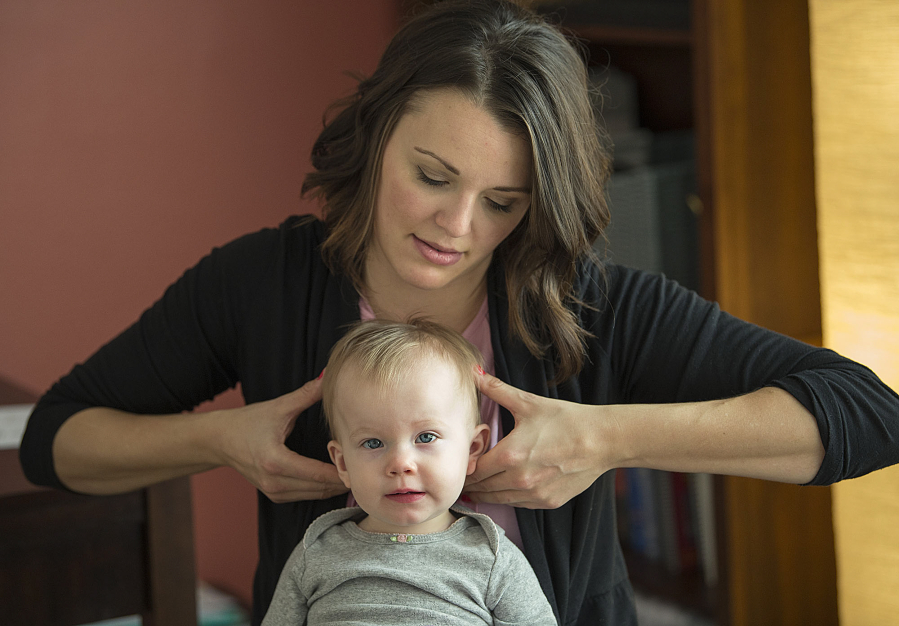Rhett Earhart lies calmly as chiropractor Cecelia Mikles runs her hands down his spine. When Mikles reaches the bottom of his spine, she notices a little curve to the left. She extends Rhett’s legs so they’re straight and checks their length. The left is a little short, she says.
Rhett rolls over to his belly, clutching a caterpillar stuffed animal and using his mom, Danielle Dearey, as a cushion between him and the chiropractic table. Mikles moves Rhett’s legs up and down, side to side, checking the mobility in his hips.
Mikles places her hands near Rhett’s hips and, with gentle pressure, holds Rhett’s sacrum — the large, triangular bone at the bottom of the spine. The hold and pressure allows Rhett’s spine to correct itself, Mikles said. Then, with a quick push from her hands, Mikles gives Rhett’s hip a manual adjustment.
“Now we’re even,” she said.
Rhett, who is 13 months old, is just learning to walk. But he’s been a patient of Mikles since he was just 6 days old.
“I just want him to be healthy,” Dearey said.
The Vancouver mom isn’t alone in that desire, nor is she alone in seeking infant chiropractic care. A 2007 study estimates there are 30 million pediatric chiropractic visits each year.
Mikles, whose practice is at the new Vancouver Wellness Studio in downtown, provides chiropractic care for infants, toddlers and children (as well as adults and pregnant women). Her youngest patient was just 2 days old.
“I think this is a vital piece of our chiropractic care that we’re missing in this country,” Mikles said. “What do small issues manifest into later?”
Tension release
At its core, chiropractic care is the use of the hands to help the body release and do its own healing, Mikles said. Reducing spinal nerve stress reduces the interference with the proper functioning of the nervous system and the body’s ability to heal.
“We’re releasing that tension and allowing the body to heal,” Mikles said.
That’s true for both adult and pediatric patients, but the methods for achieving that release of tension are different.
“When you think of chiropractic, you think push, pop, twist crack,” Mikles said, “or think we will treat (a child) the same as an adult. Obviously, that’s not the case.”
With infants, the majority of chiropractic care is about gentle ligament holds and cranial holds. With toddlers and children, Mikles still uses those holds but may also perform manual adjustments, which are much gentler than adjustments on adults.
“It’s very low-risk,” Mikles said.
The American Chiropractic Association agrees. Pediatric chiropractic care, when administered properly, is safe and effective for the treatment of a variety of conditions, according to the association. The association considers chiropractors to be important members of the integrative pediatric health care team.
Parents bring their children to Mikles for a variety of reasons. In older children, it may be because the child is complaining of neck or back pain or has scoliosis. In younger children, perhaps the child is dealing with ear infections or is falling often as they learn to walk. And with infants, parents may be concerned about a child only nursing on one side, rolling only one direction or showing discrepancies when beginning to crawl.
“They’re very squishy, but they still get subluxations (spinal misalignments) like adults do,” Mikles said. “And, luckily, they respond well to treatment.”
As 13-month-old Rhett begins to walk, Dearey feels it’s important for her son to be seen by a chiropractor to ensure he stays in alignment.
“He’s a boy. He’s rough on his body,” she said. “He’s going to get out of alignment.”
Drug-free
Mikles also sees young patients with inflammation, such as ear infections.
Brooke Freitas of Washougal brought her 13-month-old daughter, Briar, to see Mikles recently after the toddler began showing signs that she might be getting an ear infection.
Briar was diagnosed with an ear infection a couple of months ago and went through a course of antibiotics. Prior to the diagnosis, Mikles saw Briar and tried to work on her cranium — measurements of her head told Mikles that her cranium bones were shifting and uneven — but the uncomfortable toddler was fussy and didn’t want to be touched.
When Briar started showing signs of ear discomfort again, Freitas asked Mikles to take another look.
With Briar sitting on her lap, Mikles wraps her hands around Briar’s head. Mikles can feel tension on Briar’s right side and notices a slight decrease in range of motion. Mikles then takes a look inside Briar’s ears using an otoscope.
With inflammation present, Mikles tries a few techniques to help Briar’s ears drain, one of which requires Mikles to manipulate the muscle in the back of Briar’s throat. But, again, the fussy toddler resists treatment.
“That’s the fun part about working with kids,” Mikles said. “Sometimes they don’t cooperate, and that’s OK. That’s how kids are.”
When Mikles is able to work on Briar, Freitas said she sees a difference. Briar has more energy and goes back to her normal, happy self, Freitas said.
While there is a time and place for medications, Mikles said, she often sees parents who want to help their children feel better without drugs.
“It’s just amazing what you can do without drugs,” she said.




